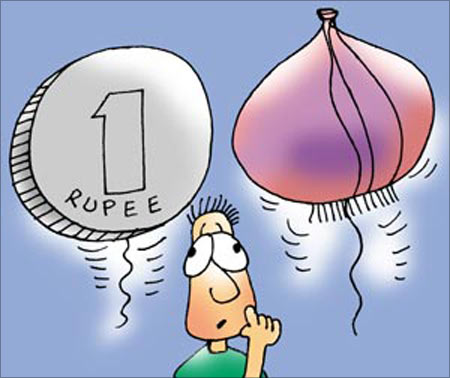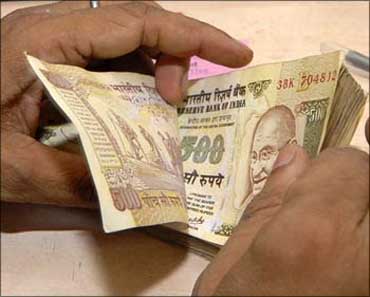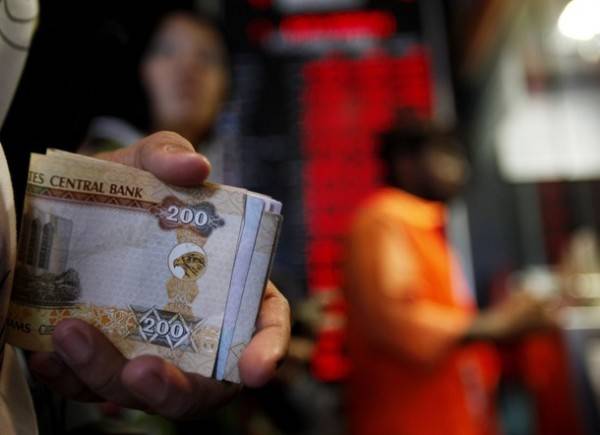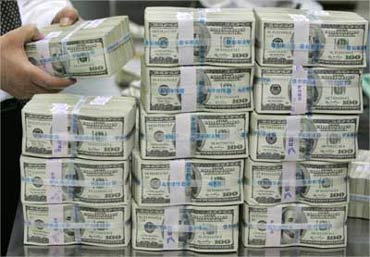Photographs: Reuters M R Venkatesh
Budget 2011 merely reflects the drift in the central government. Perhaps never in the history of independent India, with the sole exception of the period during Emergency, has the central government suffered from such a credibility crisis.
Naturally, what matters is not the deficits -- fiscal, revenue, current account, and trade -- or for that matter power, infrastructure or even manpower deficits, but the trust deficit of India.
When questioned on the state of drift by the electronic media a couple of weeks earlier, Prime Minister Manmohan Singh had blamed it on coalition compulsions.
If it is corruption, it is the ally from South India. Blame the ally from the West for inflation. Blame it on the ally from the East for Maoism, and the ally from Kashmir for the problems there.
. . .
Budget 2011 is an item number. By Sheila, for Munni!
Yet the prime minister asserts that this is not a 'lame duck' government and 'assures us' that he will complete the term little realising some analysts in the interregnum have hyphenated India with Egypt, Tunisia and Libya.
Given the state of affairs, Budget 2011 was indeed an opportunity for the central government to address this trust deficit.
Instead, the Budget turned out to be entirely vacuous, an accountant's delight interlaced with all the 'grand vision' of a gram panchayat leader.
On corruption, inflation and unemployment, the three major challenges facing the central government, the Budget has remained inexplicably and eloquently silent. The disconnect between the central government and the mood of the nation seems to be complete.
. . .
Budget 2011 is an item number. By Sheila, for Munni!
Short shrift to manufacturing
Budget 2011 seeks to enhance the share of the manufacturing sector in the national GDP from the present 16 per cent to about 25 per cent in the next 10 years.
While the intention is indeed welcome, Budget 2011 has nothing specific to help fructify that. It may be noted that several developing countries, particularly China, have realised that the road to economic nirvana is only by developing their manufacturing sector.
India, on the contrary, has attempted to adopt a unique grammar of development -- where services and not manufacturing remains the engine of growth.
While this is acceptable in the short run, the fact is that India's road to economic prosperity from now on shall impinge on our manufacturing sector.
. . .
Budget 2011 is an item number. By Sheila, for Munni!
This is simply because empirical evidence worldwide demonstrates that the growth of manufacturing sector ensures broad-based social development than the services sector.
Successive central governments have realised that this is easier said than done as the manufacturing sector, in contrast to the services sector, shall be reforms sensitive.
For manufacturing to contribute one-fourth to the national GDP, governments need to carry out intensive reforms.
These include labour law reforms, tax reforms, administrative reforms, improvement in infrastructure, etc -- all of which combine to wreak havoc on India's manufacturing competitiveness.
. . .
Budget 2011 is an item number. By Sheila, for Munni!
There is more to this. In March 2009, the rupee was traded approximately at Rs 52 to a US dollar. Since then it has appreciated 15 per cent.
It may be noted that this appreciation comes on top of the significant levels of inflation experienced by India in these two years. That roughly translates into an implicit appreciation of the rupee by more than 35 per cent in the past two years.
This explicit and implicit appreciation of the rupee is having a debilitating impact on the national manufacturing sector while simultaneously eroding our competitiveness.
Some of India's peers have neither experienced such significant bouts of inflation in this period nor have they allowed their currency to appreciate.
. . .
Budget 2011 is an item number. By Sheila, for Munni!
The net result is that we are running gargantuan trade deficits (caused to some extent by higher oil prices) -- close to $10 billion per month.
That in effect means that we are importing jobs into a country that is having huge unemployment in the first place!
Naturally the obvious question follows: Why is that the government is preventing the depreciation of the rupee to reflect our economic fundamentals?
The answer to that is not far to seek. Economic textbooks suggest that a stronger currency is an antidote to inflation.
. . .
Budget 2011 is an item number. By Sheila, for Munni!
By keeping the rupee stronger, economic managers are hoping to address the issue of inflation, little realising that it is hurting the manufacturing sector, which incidentally is barely on the radar of the national policy framers.
It may also be noted that several Asian countries have modelled their growth pattern on the back of a weak currency while maintaining lower import tariffs.
In short, given the extent of undervaluation of these currencies, import tariffs are irrelevant. But in our anxiety to match Asian rates, we seem to have forgotten the whole matrix.
And that is the crux of the issue. India is caught in a Catch-22 situation -- if it allows the rupee to depreciate, there could probably be higher inflation and should it not allow the rupee to depreciate, it could hurt Indian manufacturing, employment and our ability eradicate poverty.
. . .
Budget 2011 is an item number. By Sheila, for Munni!
But do we realise this? Forget providing a course correction, Budget 2011 does not even seem to acknowledge this difficult situation. The net result: increasingly the government is seen as being irrelevant.
But who is the beneficiary of all this? With mounting trade deficits, India is compelled to look at capital flows to bridge the current account deficits. Else we could have a repeat of 1991. That, in turn, compels the Reserve Bank of India to keep the rupee stable and, if possible, strong.
A stable rupee, it may be noted, virtually mitigates all currency risks as these are absorbed by the central bank. Naturally, a stronger and a stable rupee favours the financial sector, especially the FIIs, and positively discriminates against our domestic manufacturing sector.
In a country obsessed with Sensex and the stock markets, foreign institutional investors (FIIs) wield disproportionate influence on the national psyche and policy.
. . .
Budget 2011 is an item number. By Sheila, for Munni!
The reason for the same is not far to seek. It is generally believed that the FII route, thanks to the large regulatory gap in our capital markets that could allow a herd of elephants to walk through, allows enormous amounts of money to be first laundered away from India and then brought back through the FII route, more specifically through the Mauritius route.
The reason for using the Mauritius route is compelling -- according to the Indo-Mauritius Double Taxation Avoidance Agreement capital gains arising out of investment from Mauritius are not taxed in India and shall be taxed only in Mauritius where the tax rate is zero.
No wonder, in the past decade or so, 50 per cent of the foreign investments into India have originated from Mauritius. FII, in the Indian context, represents Foreign Indirect Investment!
Naturally, vested interests in the establishment are rooting for this arrangement to continue. And successive budgets have ensured that this arrangement not only continues but also is continuously 'liberalised'.
. . .
Budget 2011 is an item number. By Sheila, for Munni!
Budget 2011 is no different. Accordingly, it states, 'to liberalise the portfolio investment route, it has been decided to permit the Securities and Exchange Board of India-registered mutual funds to accept subscriptions from foreign investors who meet the KYC requirements for equity schemes. This would enable Indian mutual funds to have direct access to foreign investors and widen the class of foreign investors in Indian equity market.'
But there is a serious catch here -- Sebi has not prescribed the KYC norms or the Know Your Customer norms for FII investment.
And in case it inadvertently prescribes these norms, just route it through Participatory Notes (PNs). PNs, as readers may know, are peculiar instruments in the Indian markets that allow multi-layering leading to anonymity for the 'foreign' investors.
. . .
Budget 2011 is an item number. By Sheila, for Munni!
So all this allows -- even encourages -- all and sundry to first launder money from India and then bring it back through the mutual fund route.
Who said the Budget has not done anything to bring back unaccounted-for wealth of Indians parked in tax havens back into the country? Of course, it does -- with amnesty and at zero rate of tax!
It may be noted that during the course of the Budget Speech, Finance Minister Pranab Mukherjee dealt extensively on black money in six paragraphs where he was philosophical, at best, and vacuous, at worst, in his approach to fight the menace of corruption and the resultant illicit wealth.
. . .
Budget 2011 is an item number. By Sheila, for Munni!
The five-point agenda to fight black money seems to be an empty rhetoric with no concrete promises to take action against anyone.
Interestingly, the obsession of the finance minister with the Settlement Commission (also referred to as settlement through commission) -- a relic of the pre-liberalisation era -- continues.
This year the Income Tax Act has been further liberalised to include search cases provided that the additional income tax payable on the income disclosed exceeds Rs 50 lakh (Rs 5 million).
Well, that is what we call a Nalco amendment! So much for our commitment to fight corruption!
. . .
Budget 2011 is an item number. By Sheila, for Munni!
Naturally, the stock markets reacted positively to the Budget. So did the corporate sector. Little do we realise that the corporate sector contributes less than 10 per cent to the national GDP. And of this, the contribution of the listed corporates is less than 7 per cent.
As my teacher put it, tongue in cheek -- Budget 2011 is an item number at best.
Yet, the Budget is strangely benchmarked on how the corporate and stock markets react to it. The matter of Niira Radia had exposed these corporates and their functioning.
Surely, like Munni, corporate India too has lost its credibility. And so has the government.
. . .
Budget 2011 is an item number. By Sheila, for Munni!
In this scenario it is puerile to believe that the government can constructively address the structural issues facing the Indian economy.
In the process the government too is reduced to an item number.
Budget 2011, in effect, is by Sheila for Munni. Or is it the other way around?
PS: This may well be the weakest government since Independence. But are we not witness to the weakest Opposition since Independence, too? An Oppostion that allows this government to function?
The author is a Chennai-based chartered accountant. Comments can be sent to mrv@mrv.net.in
















article